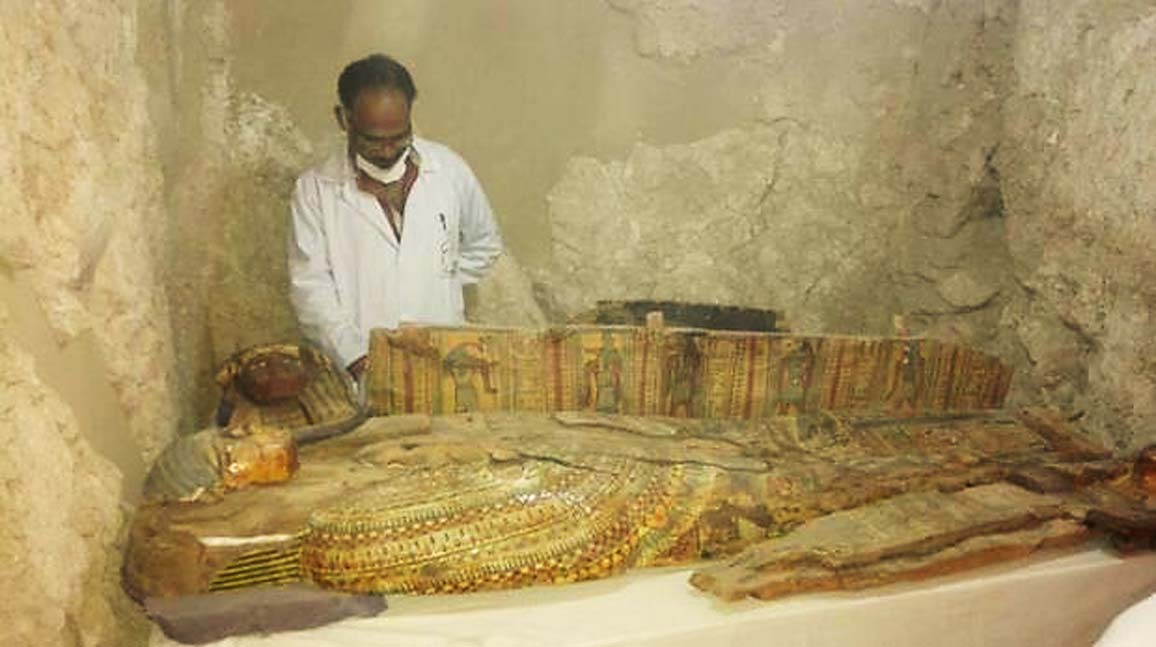Egyptian Archaeologists Reveal Massive 3500-Year-Old Tomb Contains Mummies and Thousands of Artifacts
Egyptian archaeologists in Luxor have discovered a massive ancient tomb in the city's west bank area dating back to the 18th Dynasty. The 3,500-year-old tomb contains thousands of valuable artifacts, as well as ten coffins and eight mummies.
Valuable Artifacts and Mummies
Antiquities Minister Khaled al-Anany declared yesterday the discovery of a cemetery in Luxor that contains numerous coffins, eight Pharaonic mummies, Ushabti statues, and luxurious masks decorated with gold. The archaeologists discovered the cemetery during an archaeological mission on Luxor's west bank and named it "Camp 157". The tomb dates back to the 18th Dynasty and it belonged to a city adviser named Osarhat, as Mostafa al-Waziry’s (Director General of Luxor Antiquities) told Egypt Independent. ‘’There are 10 coffins and eight mummies. The excavation is ongoing,” he says.

Some of the skulls discovered in the tomb. (Ministry of Antiquities)
For his part, Antiquities Minister Khaled el-Enany focused on the discovery of the artifacts included in the tomb and couldn’t hide his excitement. Daily Mail reports he told reporters outside the tomb:
“It was a surprise how much was being displayed inside the tomb. We found a large number of Ushabti (small carved figurines), more than a thousand of them. This is (undoubtedly) an important discovery.”
- False Doors: The Gateways to the Egyptian Underworld
- Elaborately Painted Tomb for Nobleman and Amun Temple Guardian Uncovered in Luxor

A small selection of the artifacts found in the tomb. (Ministry of Antiquities)
Ushabti figurines were usually positioned with the deceased in ancient Egypt in order to help the dead with their duties in the afterlife.
Another Important Tomb Discovered Not Too Long Ago
This is not the first time in recent years that archaeologists have discovered a tomb of this size in the area. In 2014, a team of Spanish archaeologists carrying out excavations in the Egyptian city of Luxor discovered an 11th dynasty tomb of considerable size, suggesting it belonged to a member of the royal family or someone who held a high position in the royal court.
The 4,000-year-old tomb was found in the Dra Abu el-Naga necropolis, located on the West Bank of the Nile in the ancient city of Thebes, modern-day Luxor. Human remains were found scattered around the burial chamber, at the end of a 20-meter (65.62 ft.) long underground entranceway. The tomb also contained pottery dating to the 17th dynasty, about 400 years later, suggesting that the tomb was reused.

Human remains and artifacts were found scattered in the tomb. (Ministry of Antiquities)
The Necropolis of Dra Abu el-Naga is considered to be one of the longest occupied necropolises of Ancient Egypt and it was used as a burial place almost continuously between the Middle Kingdom and the early Christian (Coptic) periods, spanning around 2,500 years. More than 160 tombs of royals, dignitaries, officials, and priests have been uncovered in the area.
Photo of the Necropolis of Dra Abu el-Naga. (LiveScience)
Coffins in Recent Discovery were in Very Good Condition
Back to 2017’s discovery, the team of archaeologists entered the tomb in order to inspect and examine the sarcophagi after taking every measure of protection, such as wearing white masks and latex gloves. According to the investigators of the tomb, the sarcophagi were covered with complicated drawings in red, blue, black, green, and yellow, and featured the carved faces of the dead. The majority of the coffins were in good condition, even though some of them had deteriorated and broken during the centuries.
Archaeologists also got a chance to examine a mummy wrapped in linen which was inside one of the coffins. White, orange, green, and patterned pots were also found in the tombs. “It is a T-shaped tomb (which) consists of an open court leading into a rectangular hall, a corridor and an inner chamber,” el-Enany stated according to the Daily Mail, and added, “A nine-metre shaft inside the tomb held the Ushabti figurines, as well as wooden masks and a handle of a sarcophagus lid.”
- Two 3,500-year-old tombs adorned with vivid paintings unearthed in Egypt
- Tomb Curses of Ancient Egypt: Magical Incantations of the Dead

These masks are just a couple of the impressive artifacts that have been found in the tomb. (Ministry of Antiquities)
An extra room was also found in the tomb, which has not been fully excavated yet. Nevine el-Aref, a spokeswoman for the antiquities ministry, stated that there is evidence and traces that new mummies should be discovered in soon, leaving hope for more exciting discoveries in the near future.
Top Image: A well-preserved wooden coffin found inside the tomb of an ancient noble in Luxor, Egypt. Source: Antiquities Ministry




















